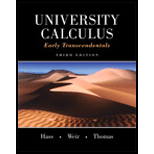
University Calculus: Early Transcendentals Plus MyLab Math -- Access Card Package (3rd Edition) (Integrated Review Courses in MyMathLab and MyStatLab)
3rd Edition
ISBN: 9780321999573
Author: Joel R. Hass, Maurice D. Weir, George B. Thomas Jr.
Publisher: PEARSON
expand_more
expand_more
format_list_bulleted
Question
Chapter A.1, Problem 7E
To determine
Solve the equation
Expert Solution & Answer
Want to see the full answer?
Check out a sample textbook solution
Students have asked these similar questions
Ministry of Higher Education &
Scientific Research
Babylon University
College of Engineering -
Al musayab
Subject :Engineering Analysis
Time: 80 min
Date:11-12-2022
Automobile Department
2nd month exam / 1" semester (2022-2023)
Note: Answer all questions,all questions have same degree.
کورس اول
شعر 3
Q1/: Use a Power series to solve the differential equation:
y" - xy = 0
Q2/:Evaluate using Cauchy's residue theorem,
sinnz²+cosz²
dz, where C is z = 3
(z-1)(z-2)
Q3/:Evaluate
dz
(z²+4)2
Where C is the circle /z-i/-2,using Cauchy's residue theorem.
Examiner: Dr. Wisam N. Hassan
Ministry of Higher Education &
Scientific Research
Babylon University
College of Engineering -
Al musayab
Subject :Engineering Analysis
Time: 80 min
Date:11-12-2022
Automobile Department
2nd month exam / 1" semester (2022-2023)
Note: Answer all questions,all questions have same degree.
کورس اول
شعر 3
Q1/: Use a Power series to solve the differential equation:
y" - xy = 0
Q2/:Evaluate using Cauchy's residue theorem,
sinnz²+cosz²
dz, where C is z = 3
(z-1)(z-2)
Q3/:Evaluate
dz
(z²+4)2
Where C is the circle /z-i/-2,using Cauchy's residue theorem.
Examiner: Dr. Wisam N. Hassan
Which degenerate conic is formed when a double cone is sliced through the apex by a plane parallel to the slant edge of the cone?
Chapter A.1 Solutions
University Calculus: Early Transcendentals Plus MyLab Math -- Access Card Package (3rd Edition) (Integrated Review Courses in MyMathLab and MyStatLab)
Ch. A.1 - Express 1/9 as a repeating decimal, using a bar to...Ch. A.1 - If 2 < x < 6, which of the following statements...Ch. A.1 - solve the inequalities and show the solution sets...Ch. A.1 - Prob. 4ECh. A.1 - Prob. 5ECh. A.1 - Prob. 6ECh. A.1 - Prob. 7ECh. A.1 - Prob. 8ECh. A.1 - Prob. 9ECh. A.1 - Prob. 10E
Ch. A.1 - Prob. 11ECh. A.1 - Prob. 12ECh. A.1 - Prob. 13ECh. A.1 - Prob. 14ECh. A.1 - Prob. 15ECh. A.1 - Prob. 16ECh. A.1 - Prob. 17ECh. A.1 - Prob. 18ECh. A.1 - Prob. 19ECh. A.1 - Prob. 20ECh. A.1 - Prob. 21ECh. A.1 - Prob. 22ECh. A.1 - Prob. 23ECh. A.1 - Prob. 24ECh. A.1 - Prob. 25ECh. A.1 - Prob. 26ECh. A.1 - Prob. 27ECh. A.1 - Prob. 28ECh. A.1 - Prob. 29ECh. A.1 - Prob. 30E
Knowledge Booster
Learn more about
Need a deep-dive on the concept behind this application? Look no further. Learn more about this topic, calculus and related others by exploring similar questions and additional content below.Similar questions
- 1/ Solve the following: 1 x + X + cos(3X) -75 -1 2 2 (5+1) e 5² + 5 + 1 3 L -1 1 5² (5²+1) 1 5(5-5)arrow_forwardI need expert handwritten solution.to this integralarrow_forwardHow to understand and learn Laurent's serial and what's the point of Laurent's serial And what are the steps of a smooth solution for Laurentarrow_forward
- Example: If ƒ (x + 2π) = ƒ (x), find the Fourier expansion f(x) = eax in the interval [−π,π]arrow_forwardPlease can you give detailed steps on how the solutions change from complex form to real form. Thanks.arrow_forwardExamples: Solve the following differential equation using Laplace transform (e) ty"-ty+y=0 with y(0) = 0, and y'(0) = 1arrow_forward
Recommended textbooks for you
 Calculus: Early TranscendentalsCalculusISBN:9781285741550Author:James StewartPublisher:Cengage Learning
Calculus: Early TranscendentalsCalculusISBN:9781285741550Author:James StewartPublisher:Cengage Learning Thomas' Calculus (14th Edition)CalculusISBN:9780134438986Author:Joel R. Hass, Christopher E. Heil, Maurice D. WeirPublisher:PEARSON
Thomas' Calculus (14th Edition)CalculusISBN:9780134438986Author:Joel R. Hass, Christopher E. Heil, Maurice D. WeirPublisher:PEARSON Calculus: Early Transcendentals (3rd Edition)CalculusISBN:9780134763644Author:William L. Briggs, Lyle Cochran, Bernard Gillett, Eric SchulzPublisher:PEARSON
Calculus: Early Transcendentals (3rd Edition)CalculusISBN:9780134763644Author:William L. Briggs, Lyle Cochran, Bernard Gillett, Eric SchulzPublisher:PEARSON Calculus: Early TranscendentalsCalculusISBN:9781319050740Author:Jon Rogawski, Colin Adams, Robert FranzosaPublisher:W. H. Freeman
Calculus: Early TranscendentalsCalculusISBN:9781319050740Author:Jon Rogawski, Colin Adams, Robert FranzosaPublisher:W. H. Freeman
 Calculus: Early Transcendental FunctionsCalculusISBN:9781337552516Author:Ron Larson, Bruce H. EdwardsPublisher:Cengage Learning
Calculus: Early Transcendental FunctionsCalculusISBN:9781337552516Author:Ron Larson, Bruce H. EdwardsPublisher:Cengage Learning

Calculus: Early Transcendentals
Calculus
ISBN:9781285741550
Author:James Stewart
Publisher:Cengage Learning

Thomas' Calculus (14th Edition)
Calculus
ISBN:9780134438986
Author:Joel R. Hass, Christopher E. Heil, Maurice D. Weir
Publisher:PEARSON

Calculus: Early Transcendentals (3rd Edition)
Calculus
ISBN:9780134763644
Author:William L. Briggs, Lyle Cochran, Bernard Gillett, Eric Schulz
Publisher:PEARSON

Calculus: Early Transcendentals
Calculus
ISBN:9781319050740
Author:Jon Rogawski, Colin Adams, Robert Franzosa
Publisher:W. H. Freeman


Calculus: Early Transcendental Functions
Calculus
ISBN:9781337552516
Author:Ron Larson, Bruce H. Edwards
Publisher:Cengage Learning
Implicit Differentiation with Transcendental Functions; Author: Mathispower4u;https://www.youtube.com/watch?v=16WoO59R88w;License: Standard YouTube License, CC-BY
How to determine the difference between an algebraic and transcendental expression; Author: Study Force;https://www.youtube.com/watch?v=xRht10w7ZOE;License: Standard YouTube License, CC-BY